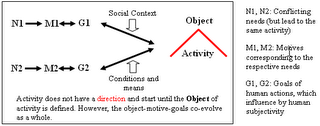Zone of Proximal Development ZPD
Vygostsky (1978) defined the Zone of Proximal Development (ZPD) as the difference between a child's actual developmental level as determined by independent problem-solving and the level of potential development as determinded through problem-solving under adult guidance or in collaboration with more capable peers.
According to Vygotsky, essential feature of learning is that it creates the Zone of Proximal Development (ZPD). Learning (activity) awakens a variety of internal developmental processes that are able to operate only when the learner is interacting with people in his environment and in cooperation with his peers.
Maturing and developing mental functions of a learner must be fostered and assessed through collaborative, not independent or isolated activities. He claimed that the intellectual skills learners acquire are directly related to how they interact with others in specific problem-solving environments. Learners internalize and transform the help they receive from others and eventually use these same means of guidance to direct their subsequent problem-solving behaviours. Therefore, the nature of social transactions is central to a ZPD analysis. In this way, what learners can perform collaboratively or with assistance today they can perform independently and competently tomorrow.
He argued that standard tests (e.g. IQ test) in our education system give a picture only of completed development. They assess mental functioning that has already matured, fossified. The information from these assessments is of little use in the important task of instruction (teaching and learning). He believed it was the duty of school system to bring out the full potential of each student. The task cannot be accomplished by assuming that completed development fully specifies a trajectory for the future. The standardised assessment strategy leads to a false understanding of the relation between development and instruction, which converts the school system into a vast selection machine.
However, we should think of ZPD as a characteristic not solely of the learning or teaching but of the student engaged in collaborative activity within specific social environments. The focus is on the social system within which we hope students learn, with the understanding that this social system is mutually and actively created by teacher and students.
ZPD reminds us that educational settings are social creations. They are socially constituted, and they can be socially changed. It warns us how easy it is to under-estimate students' and teachers' abilities when we analyze them in isolation. It points to the use of social and cultural resources that represent our primary tools, as human beings, for mediating and promoting change.
According to Vygotsky, essential feature of learning is that it creates the Zone of Proximal Development (ZPD). Learning (activity) awakens a variety of internal developmental processes that are able to operate only when the learner is interacting with people in his environment and in cooperation with his peers.
Maturing and developing mental functions of a learner must be fostered and assessed through collaborative, not independent or isolated activities. He claimed that the intellectual skills learners acquire are directly related to how they interact with others in specific problem-solving environments. Learners internalize and transform the help they receive from others and eventually use these same means of guidance to direct their subsequent problem-solving behaviours. Therefore, the nature of social transactions is central to a ZPD analysis. In this way, what learners can perform collaboratively or with assistance today they can perform independently and competently tomorrow.
He argued that standard tests (e.g. IQ test) in our education system give a picture only of completed development. They assess mental functioning that has already matured, fossified. The information from these assessments is of little use in the important task of instruction (teaching and learning). He believed it was the duty of school system to bring out the full potential of each student. The task cannot be accomplished by assuming that completed development fully specifies a trajectory for the future. The standardised assessment strategy leads to a false understanding of the relation between development and instruction, which converts the school system into a vast selection machine.
However, we should think of ZPD as a characteristic not solely of the learning or teaching but of the student engaged in collaborative activity within specific social environments. The focus is on the social system within which we hope students learn, with the understanding that this social system is mutually and actively created by teacher and students.
ZPD reminds us that educational settings are social creations. They are socially constituted, and they can be socially changed. It warns us how easy it is to under-estimate students' and teachers' abilities when we analyze them in isolation. It points to the use of social and cultural resources that represent our primary tools, as human beings, for mediating and promoting change.



